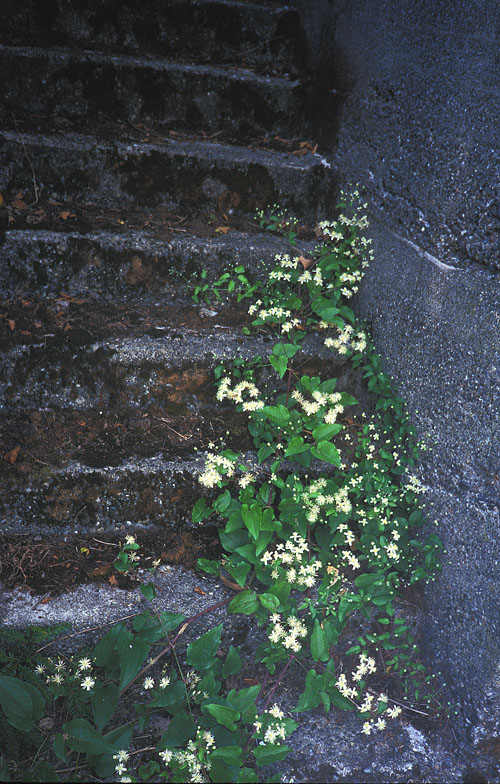
|
| Wild Clematis; Clematis Vitalba L. |
Buttercup Family; RANUNCULACEÆ
|
| Smothering vines are disgustingly familiar to Seattleites. We suffer from wild Morning-Glory, with its white trumpet flowers,
string-like stems and limp, stinking foliage; Ivy that thinks it owns the world; and our present subject: unbridled Clematis. All three pests
are invaders from the Old World, although human newcomers looking around would never know it, because the rampant plants are
practically everywhere. |
| More than 200 Clematis species exist. None is native in Seattle, but citizens grow dozens of species and varieties. As if separated
by a great chasm, we have Clematis Vitalba versus all the rest. It is no contest, really. In vigor, size and impact, this naturalized species
proves more assertive than all the rest put together. It grows 100 feet into native trees, with its stems near the ground 3 inches thick. Acres
of greenbelts and parks are covered with it. Underneath freeways and bridges it grows. Frequently it shares space with its twin
tree-strangler: ivy. All of us who care about natural history should be acquainted with this insatiable, if beautiful, beast. |
| It is native in Europe, north Africa and southwest Asia. The name vitalba is derived from the Latin "vitis alba," or white vine. An
Italian name is "Vitalba," and the Spanish say "Vidalba." The most common English names are "Traveller's Joy" and "Old Man's Beard."
Other fun old names include: Hag Rope, Bellywind, Crocodile, Robin Hood's Fetters, Old Man's Woozard, Graybeards, Beggar Brushes
--and my favorite: Love Entangled. A French name is "Barbe au bon Dieu." |
| Describing the vine explains these names. It is deciduous, and climbs by grasping with its leafstalks. Thus it is unlike grapes, that
cling using tendrils, and ivy, that roots profusely. It will grab anything in sight, and if nothing else is around, it will twine about
itself. The shoots emerge in March, and are attractively shining with their bright green growth, covered lightly with a sheen of clear hairs. A purplish
color is present on the grooved shoots. In June it opens the first of its small, numerous, sweet star-like flowers of creamy white. Successive
flowers keep appearing all summer, giving rise to conspicuous seedheads. The young seedheads are purplish and greenish-white; but at
maturity each seed has a whispy silvery-white tuft, somewhat like a dandelion plume. It is these persistent, airy seedheads that make the vine
stand out. |
| The leaves are compound, of usually 5 or 7 leaflets, thin, with a rubbery texture, unremarkable color, and weakly acrid scent. A
late, dull-yellowish-purple fall color sets in. At the end of the growing season, the thicker shoots have become semi-barked, on their way
to becoming mature, dirty straw-colored, stout and strong. Children can play Tarzan of the Apes very well on the thicker vines. A very
good grip is afforded, and the strength of the fibers is amazing. With great age, the outermost bark peels off in thin shreds. |
| Let us examine its virtues and vices. It is a useful plant to combat erosion, tolerating any sort of soil and needing little sunlight.
On the other hand, its unrestrained growth into trees, forming thereby giant, oppressively shady bowers, blocks light, hurting many
native plants. The mechanical damage caused by the weight of its stems and masses of leaves is also a concern. Its numerous seeds give rise
to seedlings that can bother those of us who garden. The water its roots demand could be used by other plants. But what an impressive
sight in all its glory of summer flower or winter seed crop! An air of tropical luxuriance is obvious. |
| Aside from ornament where there is plenty of room, its other uses are few. In Europe, some people preserved the young shoots
in vinegar as a condiment. Always keen on eating, I tried eating the tender shoots, both raw and cooked Yecch! I found the flavor
detestably bitter and burning. The fibrous stems are useful in basketry. Medical practitioners as a group have found it useless. However the
famous Edward Bach adopted this clematis as one of his 12 healing herbs. It is, he asserted, useful for those of us who are bored or suffer
from insufficient zest. |
A final note: for years I, like others, confused this with a species that is native east of the Cascades.
Clematis ligusticifolia is indeed a close cousin, but has thicker, darker, narrower leaves, more toothed, less hairy, with more prominent veins; its seeds are smaller,
with more per cluster. It is less aggressive. I am not aware of its existence in the Seattle area.
|
Originally published as the Seattle Tilth newsletter Weed of the Month in May 1991, along with an illustration from a book.
Back |
|
|

